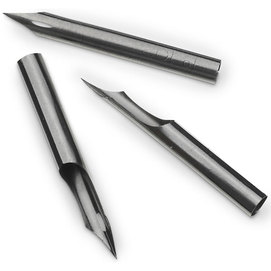
A Crow Quill pen is the finest of steel drawing pens. The nib of the crow quill is extremely slender and firm, allowing very delicate and precise lines to be drawn. Prior to the production of steel nibs in the early 19th century, the crow quill pen was actually made from the wing feather of a crow.
There are many others nibs for drawing and lettering available to artists to try. These were once part of every artists tool kit and should still be included.
There are many others nibs for drawing and lettering available to artists to try. These were once part of every artists tool kit and should still be included.
Inks
Ink that should be used in a work of art is called drawing ink and is especially made for use in permanent works of art and will not fade over time with exposure to light. A permanent or water resistant form is called India ink, but there are also water soluble forms that may be preferred for very fine lines and delicate manipulations.
Chinese ink is similar to India in, with minor ingredients added to enhance brilliancy, working qualities and range of tone. After it's made it is dried into sticks or cakes, which the artist puts into solution by rubbing the ends on an ink stone with a little water. I've also purchased this in liquid form.
Japanese ink, also called sumi or black watercolor, is made in sticks resembling their Chinese counterpart. Distinguished by numerous subtleties of quality and grade, the sticks are made and used according to ancient traditions. Although it may seem tedious to use stick ink and grind it on an ink stone, I find it is very much a part of the creative process.
Try different inks with a crow quill and brush, to find what works best for you. Also try different papers.
Ink that should be used in a work of art is called drawing ink and is especially made for use in permanent works of art and will not fade over time with exposure to light. A permanent or water resistant form is called India ink, but there are also water soluble forms that may be preferred for very fine lines and delicate manipulations.
Chinese ink is similar to India in, with minor ingredients added to enhance brilliancy, working qualities and range of tone. After it's made it is dried into sticks or cakes, which the artist puts into solution by rubbing the ends on an ink stone with a little water. I've also purchased this in liquid form.
Japanese ink, also called sumi or black watercolor, is made in sticks resembling their Chinese counterpart. Distinguished by numerous subtleties of quality and grade, the sticks are made and used according to ancient traditions. Although it may seem tedious to use stick ink and grind it on an ink stone, I find it is very much a part of the creative process.
Try different inks with a crow quill and brush, to find what works best for you. Also try different papers.



 RSS Feed
RSS Feed